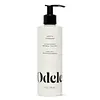What's inside
What's inside
 Benefits
Benefits

 Concerns
Concerns

 Ingredients Side-by-side
Ingredients Side-by-side

Lactobacillus/Arundinaria Gigantea Ferment Filtrate
Skin ConditioningGlycerin
HumectantLactobacillus Ferment
Skin ConditioningStearyl Alcohol
EmollientCocos Nucifera Fruit Extract
EmollientSqualane
EmollientPhyllostachys Bambusoides Extract
Skin ConditioningSalvia Hispanica Seed Extract
EmollientSaccharomyces Cerevisiae Extract
Skin ConditioningBehentrimonium Methosulfate
Cyamopsis Tetragonoloba Gum
Emulsion StabilisingPCA Glyceryl Oleate
EmollientSelaginella Lepidophylla Extract
EmollientCetyl Alcohol
EmollientEuterpe Oleracea Sterols
Skin ConditioningParfum
MaskingLinalool
PerfumingButylene Glycol
HumectantLimonene
PerfumingLinoleic Acid
CleansingOleic Acid
EmollientCitral
PerfumingLinolenic Acid
CleansingLactobacillus/Arundinaria Gigantea Ferment Filtrate, Glycerin, Lactobacillus Ferment, Stearyl Alcohol, Cocos Nucifera Fruit Extract, Squalane, Phyllostachys Bambusoides Extract, Salvia Hispanica Seed Extract, Saccharomyces Cerevisiae Extract, Behentrimonium Methosulfate, Cyamopsis Tetragonoloba Gum, PCA Glyceryl Oleate, Selaginella Lepidophylla Extract, Cetyl Alcohol, Euterpe Oleracea Sterols, Parfum, Linalool, Butylene Glycol, Limonene, Linoleic Acid, Oleic Acid, Citral, Linolenic Acid
Alternatives
Ingredients Explained
These ingredients are found in both products.
Ingredients higher up in an ingredient list are typically present in a larger amount.
Parfum is a catch-all term for an ingredient or more that is used to give a scent to products.
Also called "fragrance", this ingredient can be a blend of hundreds of chemicals or plant oils. This means every product with "fragrance" or "parfum" in the ingredients list is a different mixture.
For instance, Habanolide is a proprietary trade name for a specific aroma chemical. When used as a fragrance ingredient in cosmetics, most aroma chemicals fall under the broad labeling category of “FRAGRANCE” or “PARFUM” according to EU and US regulations.
The term 'parfum' or 'fragrance' is not regulated in many countries. In many cases, it is up to the brand to define this term.
For instance, many brands choose to label themselves as "fragrance-free" because they are not using synthetic fragrances. However, their products may still contain ingredients such as essential oils that are considered a fragrance by INCI standards.
One example is Calendula flower extract. Calendula is an essential oil that still imparts a scent or 'fragrance'.
Depending on the blend, the ingredients in the mixture can cause allergies and sensitivities on the skin. Some ingredients that are known EU allergens include linalool and citronellol.
Parfum can also be used to mask or cover an unpleasant scent.
The bottom line is: not all fragrances/parfum/ingredients are created equally. If you are worried about fragrances, we recommend taking a closer look at an ingredient. And of course, we always recommend speaking with a professional.
Learn more about Parfum